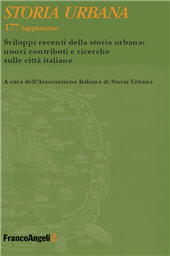Ripensare la storia urbana tra digital, public e nuovi strumenti di divulgazione : l'esperienza di Urban Genoma
9-20 p.
Il contributo svolge alcune riflessioni sulle trasformazioni in atto nel campo della storia urbana prendendo spunto dall'esperienza milanese e dai cambiamenti e dalle sollecitazioni che l'Expo del 2015 ha prodotto sulla città. Dopo aver evidenziato la varietà, ma anche i limiti, degli accostamenti alla storia e allo sviluppo della città praticati in precedenza si sono evidenziate, a partire da numerose esperienze realizzate all'estero, le opportunità aperte dalle nuove tecnologie e le potenzialità di una nuova disseminazione in grado di connettere gli ambienti accademici a un pubblico più ampio. In questa prospettiva si sono indirizzate le iniziative intraprese dopo l'Expo da Urban Genoma, un centro di ricerca che riunisce competenze molteplici in grado di fornire uno sguardo plurale sulla città. Il percorso sin qui compiuto ha consentito, non solo una notevole attività conoscitiva, ma anche di individuare iniziative e formulare progetti volti a costruire un ponte tra i saperi universitari e il composito
mondo di chi le città le vive e le abita, in modo da portare le conoscenze fuori dalle aule trasformandole in uno strumento utile a costruire una cittadinanza consapevole. [Testo dell'editore]
The paper makes some reflections on the limits and possible developments of urban history starting from the Milanese case and the experience of Urban Genoma (UG), a reality that intends to enhance the urban heritage on several levels, using the traces of the past to build in a coordinated way a shared identity able to reinforce the recognisability and attractiveness of places. In this regard, Milan represents a very interesting laboratory because, despite its significant historical importance, in the collective imagination it appears as a city "without history", looking to the future rather than to the past. After reconstructing the initiatives that have dealt from different perspectives, with the Milanese reality and its past, the contribution dwells on two areas, practised by UG, that seem particularly promising: the first is the application of new technologies to urban history, the second is the public valorisation of knowledge that makes "the past in the present" experimentable and usable. The aim is to
represent in new and more easily understandable and usable ways a tangible and intangible cultural-historical heritage which, although preserved, is becoming less and less accessible. At the same time, it is essential that the knowledge and information owned by the specialists be able to take forms that make it usable, but above all attractive and interesting, for a broader public as well, so as to overcome the self referentiality of many discourses on cities and their development.[Publisher's text]
-
Articles from the same issue (available individually)
-
Information
ISSN: 1972-5523
KEYWORDS
- Milano Storia urbana digitale Public history Urban Genoma
- Urban history, Milano, Digital History, H-GIS, Cultural Heritage, Urban Genoma


